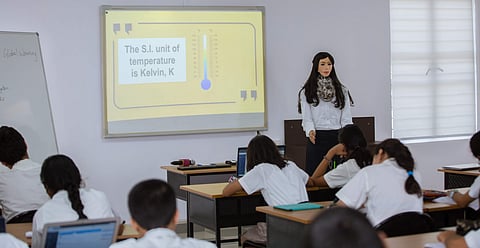

We have seen robots serve food in cafeterias and restaurants, but for the first time in India, robot teachers have been introduced in Bengaluru’s Indus International School for a completely different purpose. These Artificial Intelligence-enabled robots will assist teachers in the classroom and also clear the doubts of students. The school's tech team that comprises developers, programmers, graphic designers, content developers and experienced teachers have built three such robots. The idea behind building these robots is to help teachers do something different for children rather than deliver the same content straight from the textbooks.
Vignesh Rao, Chief Design Officer, Indus International School, says, "We follow something called the collaborated learning model, wherein the teachers, students and the robots can function together in the classroom. These days, teachers spend 90 per cent of their time delivering some particular content to the students that is already available on the internet. I think teachers must teach students how to apply the content to solve real-life problems. Therefore, these robots are built to deliver the content and teachers will help students in using the relevant topic or solution to solve a problem and motivate them. We feel that the internet cannot motivate children, it can only provide content."
With the advanced functions of robots, there is always this fear among people that they will replace humans, especially teachers. Regarding this, Vignesh clarifies, "The notion that robots can replace teachers is wrong. Robots can only assist teachers but there needs to be a human touch. Teachers must personalise learning for children and inspire them."
The speciality of these robots is that they can answer any question posed by students. Similarly, the robot will ask students different questions. And if the students' answers are not appropriate, then the robots will tell them the right answer. Also, they have been built in such a way that at the end of every lesson, there is an automated online assessment conducted for the students. The students will receive a link on their laptops where they answer a few questions and this is checked immediately. While the students get to know their marks, the teachers get to analyse the overall performance of the class. They can analyse the areas in which the class needs improvement and the areas they are good at.
Explaining that the robots were not introduced to students all at once. Vignesh says, "These robots have been undergoing trials for the last one year. Every time the robot taught students in the classroom, we would take their feedback and improve the functions. It was only in August 2019 that the robots started taking full-time classes for students studying in class VII, VIII and IX. The team is planning to introduce these robots even for primary classes, including class III, IV and V. They can deliver content on subjects like Physics, Chemistry, Biology, Geography and History. We also plan on increasing the number of subjects they can teach as the robots are capable of teaching subjects like English, Math and so on too."
Vignesh and his team took approximately two years to build these robots. While they spent a year researching the requirements of the project, another year was spent on building the robots. He says, "Robots being used to assist teachers or teach students is something that is happening for the first time in India as well as the world. We faced several challenges while building our first robot, Eagle. Our primary challenge was to understand the mindset of people and convince them that robots can't replace humans. Until now, AI hasn’t been used in education much and we have explored it for the first time. When we watch films, we see robots fly, dance and do everything. Here, we wanted to use them for the purpose of education. This technology is not common and optimising it, getting the best of it at a good cost and putting it to the best use, was another challenge. We had partners in China and the USA, and so, a few of our team members were sent to these countries to learn some skills. Most of the equipment used to make the robots have been bought from China and the USA."
Named Eagle, Eagle 1.0 and Eagle 2.0, they vary in functions like speed, content delivery and performance. They are five feet and seven inches tall and appear human-like, with skin made of silicone. One can connect a PowerPoint presentation to these robots so that students can understand the content clearly. "When we first introduced the robots in the classrooms, kids were fascinated by the way it functioned. Children also connected with the robot emotionally.
The robots require constant updating in terms of content and features too," says Vignesh, whose team is working to launch another robot by March 2020. When we ask if there are enough skilled workers to build robots in India, Vignesh says, "No, we don't have enough people when it comes to skills to build robots that have advanced features. What I suggest is to introduce subjects related to robotics and functions in the school curriculum itself. Indus International School has coding as a part of the curriculum from the primary level up to class XII and our students have already started working on drones and Automated Vehicle Systems."
